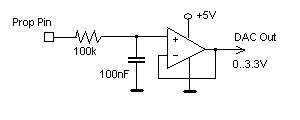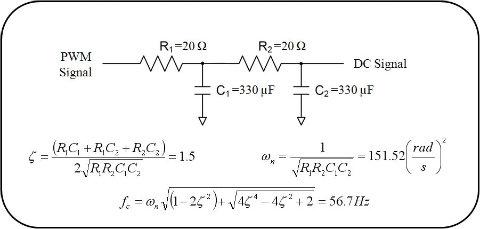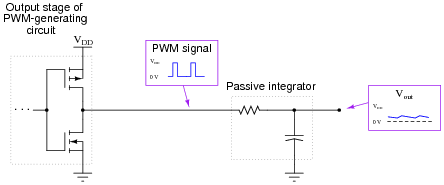PWM DAC Low Pass Filtering
【TI博客大赛】【原创】LM3S811之基于PWM的DAC
http://bbs.ednchina.com/BLOG_ARTICLE_3005301.HTM
http://www.fpga4fun.com/PWM_DAC_3.html
One-bit DAC
Take one pin of an FPGA, connect a speaker and listen to an MP3? Easy.
Here, we'll use a PC to decode an MP3, and then send the decoded data to an FPGA that is configured as a one-bit DAC.

- 1. A speaker is connected directly to the FPGA. Since the speaker is mostly inductive, we control the current inside the speaker. That works, but is only recommended with high-impedance input speakers (or earphones).
- 2. An RC filter is used, then comes a speaker or amplified-speaker. That works only if the speaker has a high-enough input impedance so that it doesn't disturb the RC filter.
- 3. An RC filter is followed by an op-amp. That's the way to use to get the best music quality.
That's it! Listen to your favorite MP3 through an FPGA.
T5 dimming using 0-10V
http://forum.arduino.cc/index.php?topic=21889.0
An op-amp is capable of sourcing and sinking so it will work as a "buffer" as you require. I think you want something like this:

how to generate an analog output from a in-built pwm of Atmega 32AVR microcontrloller?
Please help me at how to generate a variable analog signal(0-5V) from a in-built AVR microcontroller's PWM(0-5V). I am doing a project on I-V data logger.I am using a MOSFET as variable load & want to drive the gate voltage(Vgs) of MOSFET by a variable voltage which comes from pwm of microcontroller. I would be very happy if somebody come up with answer. Thanks in advance.
Nagu Bhanoth
you need a resistor, a capacitor and an opamp.
opamp is not really necessary when you are driving a mosfet, but will make life a bit easier.

just be aware, that this dac will be quite noisy or/and slow. The bigger cap/resistor values, quiter and slower the output.
another thing to be aware is that you better use 16bit pwm, as 8 bit pwm will give you only 256 discrete values - that could be enough or too coarse, depends on your application, of course.
just google "PWM DAC" for more info and calculations.
one more thing - you could put several resistor/capacitor stages in series to improve on the noise side:

Create a Low-Pass RC filter that will filter out the frequency of your PWM. The cutoff frequency should be at least 10 times lower than the frequency of your PWM. A lower cutoff frequency will reduce the voltage ripple in the output signal.
Cutoff frequency is determined by:
f = 1/(2πRC)
Further reading:
http://provideyourown.com/2011/analogwrite-convert-pwm-to-voltage/
Arduino’s AnalogWrite – Converting PWM to a Voltage
http://provideyourown.com/2011/analogwrite-convert-pwm-to-voltage/

PWM Primer
Pulse width modulation (or PWM as it is most commonly known), is a way of encoding a voltage onto a fixed frequency carrier wave. Commonly used for radio controlled devices, it is similar to FM (frequency modulation) or AM (amplitude modulation) in what it accomplishes. Each type of modulation scheme has its own advantages and disadvantages. AM modulation was the first type of modulation used for radio transmissions. It is the most simple modulation scheme to implement, requiring only a single transistor or vacuum tube amplifier as was done in the early days of radio. However, it suffers from excessive noise and therefore, FM modulation was invented. In this modulation technique, the voltage signal is no longer related to the strength of the signal. That is why FM radio has superior noise and fidelity qualities over AM radio, though it is not as simple to implement in circuitry.
With the need for digital communication, a new modulation technique was invented – PWM. This technique shares the same noise immunity as FM, to which it is very similar. The biggest difference is the simplicity and digital nature of the modulation. Instead of varying the modulation frequency with voltage, an output is merely switched on and off at a fixed frequency. The percentage of the on-time is in proportion to the signal voltage. To see better what this means, let’s examine what a PWM signal looks like for various levels. In the following image, the duty cycle is the output value from the PWM pin of an Arduino divided by 255:

For the Arduino, you write a value from 0 to 255 on a PWM pin, and the Arduino library will cause the pin to output a PWM signal whose on time is in proportion to the value written.
When it comes time for us to actually write an output voltage, the 0-255 value lacks meaning. What we want is many cases is a voltage. For our purposes, we will assume the Arduino is running at Vcc = 5 volts. In that case, a value of 255 will also be 5 volts. We can then easily convert the desired voltage to the digital value needed using simple division. We first divide the voltage we want by the 5 volts maximum. That gives us the percentage of our PWM signal. We then multiply this percentage by 255 to give us our pin value. Here is the formula:
Pin Value (0-255) = 255 * (AnalogVolts / 5);
Low Pass Filtering
Now that you understand how PWM works and can even change the frequency, it is time to take a look at how to implement a simple low pass filter. This simple piece of circuitry will convert your PWM output into a voltage corresponding to the percentage of the PWM waveform. You will then have a complete D-A converter for your Arduino or other microcontroller.

RC Low Pass Filter
If we examine the circuit on the left, when a voltage is applied to the input of R, the capacitor C will begin to charge. When it is charged, it will cease to conduct current and the voltage at the output of this circuit will match the input (assuming a high impedance load). If you remember that capacitors block DC currents, but pass AC currents, you can see that any DC voltage input will also be output, but high frequency AC voltages will be shorted to ground. For anything in between, i.e. lower frequency AC voltages, they will be filtered according to the R/C time constant formed by the resistor-capacitor network.
While this circuit is very simple, choosing the appropriate values for R & C encompass some design decisions – namely, how much ripple can we tolerate and how fast does the filter need to respond? These two parameters are mutually exclusive. In most filters, we would like to have the perfect filter – one that passes all frequencies below the cutoff frequency, with no voltage ripple. While no such ideal filter exists, we can achieve close to it by using a multiple pole filter. Such a filter would incorporate many components in a ladder configuration. While such a filter has wonderful performance characteristics, its complexity and cost is unnecessary for simple D-A conversion.
In such cases, we only need a simple single pole filter as shown above. We can achieve a reasonable voltage ripple for a single price – a low cutoff frequency. A low cutoff frequency has two ramifications. First, it limits the speed by which we can vary our output voltage. Second, there is a response delay when changing the voltage until the steady-state voltage is reached. For many of the more common applications, this trade-off is perfectly acceptable. Let’s now look at an example.
First, let’s choose our maximum ripple voltage. When we filter this high frequency PWM signal, a small component of it will always make it through the filter. That happens because our capacitor is too small to filter it out entirely. We could choose a very large capacitor /resistor combination that would get a very high proportion of it, but then it would take a long time to reach the proper output voltage as the capacitor charges. That would greatly limit how fast our signal can change and be seen at the output. Therefore, we need to choose a reasonable value for the ripple voltage. A popular application would be to change the voltage of a MOSFET. Since MOSFETs are voltage controlled devices, we can easily drive them with our microcontroller with PWM and a low-pass filter. Any ripple voltage present at the input would also be present at the output. For this example, assume the MOSFET will be driving a non-critical load such as a high power LED. In this instance, we merely need to stay within reasonable limits so the peak current in the LED will not be exceeded. In this case a 0.1 volt ripple would be more than adequate.
Next we choose a capacitor value. While it would seem the next step would be choosing a cutoff frequency (and it normally would be), there are additional considerations such as output load and capacitor cost. If we were only driving the gate of a MOSFET, there would be no output load to speak of. In such case, we could choose a cheap ceramic cap such as 0.1uF and then choose the resistor we need to achieve the cutoff frequency desired. If, on the other hand, we need some current from our output, then we will need a smaller resistor and a correspondingly larger capacitor. For a recent circuit, I found I needed a 2.2uF capacitor to prevent my modest load from altering the output voltage too significantly. Designing this circuit for non-trivial loads is beyond the scope of this article. If you find yourself in such a need, the best approach would be to start with at least a 1uF capacitor and then test how your output voltage changes with load. Increase your capacitor until the load has a low enough effect to be acceptable. Another way to look at this circuit would be to think of it as a poorly regulated power supply. It only meant to convert digital signals to an output voltage; not to drive a load as well. Buffer the output with an op-amp or a FET first. Then drive your load.
For our example, let’s choose a capacitor value of 1.0uF. For driving a MOSFET, you can use something even smaller, but this size will let us have a small load. Next, we need to choose a cutoff frequency or response time. These two parameters are related but not the same. For simple things like driving LEDs, we are more concerned with a response time. Our response time can be pretty generous. Let’s choose a settling time (to reach 90% of the final value) of 0.1 seconds, which would require a resistor of 15K ohms.
You may be wondering how to calculate these values, or others of your own. Rather than delve into a lot of equations, I have found something better. This excellent online calculator does all the hard math for you, calculating cutoff frequency, response times, voltage ripple and other values. It even draws a transient analysis graph for you – displaying your ripple and how the voltage ramps up over time. Here is the output graph for this example:

RC Low Pass Filter Time Response http://sim.okawa-denshi.jp/en/PWMtool.php
http://sim.okawa-denshi.jp/en/CRtool.php
AVR131: Using the AVR’s High-speed PWM
http://www.atmel.com/Images/doc2542.pdf
Theory of Operation
PWM combined with an analog filter can be used to generate analog output signals, i.e. a digital to analog converter (DAC).
A digital pulse train with a constant period (fixed base frequency) is used as a basis.
To generate different analog levels, the duty cycle and thereby the pulse width of the digital signal is changed.
If a high analog level is needed, the pulse width is increased and vice versa.
Averaging the digital signal over one period (using an analog low-pass filter) generates the analog signal.
A duty cycle of 50% gives an analog signal with half the supply voltage, while 75% duty cycle gives an analog signal with 75% supply voltage.
Examples on filtered output signals are shown at the end of this document.
The analog low-pass filter could be a simple passive RC-filter for instance.
The filter removes the high PWM base frequency and lets through the analog signal.
The filter crossover frequency must be chosen high enough to not alter the analog signal of interest.
At the same time it must be as low as possible to minimize the ripple from the PWM base frequency.

If the analog signal is fed to a low-impedance input, a buffer amplifier should be connected between the filter output and the load.
This will prevent the load from discharging the capacitor and creating ripple voltages.

The following scope pictures are examples of sine wave signals generated by the ATtiny26 PWM.
The scope snap-shots show the output on the OC1A pin, which is the digital pulse modulated signal, and the filtered/shaped PWM signal.
A simple RC filter is used to shape the PWM signal to a sine wave – an analog signal where the amplitude is given by the duty cycle of the PWM output.
The RC filter used has an R = 10 kΩ and a C = 100 nF, resulting in a filter crossover frequency of 1 kHz,
which will let the low frequency sine wave pass while filtering out the high frequency PWM base.


http://www.allaboutcircuits.com/worksheets/dac.html

Digital-to-Analog conversion
Question 1:
Follow-up question #1: why is it important that the circuit generating the PWM signal for the integrator be able to both source and sink current?
Follow-up question #2: what would have to be done to reduce the ripple voltage at the integrator's output?
Although it should not be difficult for students to discern the relationship between duty cycle and DC output voltage, the application of this relationship to data communication might be difficult for some students to grasp, especially on their own. Further elaboration on your part may be necessary.
An excellent example of this principle applied is the generation of an analog voltage by a 1-bit digital circuit. This technique is useful in microcontroller systems where output ports may be scarce, provided that ripple voltage (or slow response) is not a problem.
PWM DAC Low Pass Filtering的更多相关文章
- PWM DAC vs. Standalone
http://analogtalk.com/?p=534 http://analogtalk.com/?p=551 Posted by AnalogAdvocate on April 09, 2010 ...
- 【STM32】PWM DAC基本原理(实验:PWM实现DAC)
虽然STM32F103ZET6具有内部DAC,但是也仅仅只有两条DAC通道,并且STM32还有其他的很多型号是没有DAC的.通常情况下,采用专用的D/A芯片来实现,但是这样就会带来成本的增加. 不过S ...
- Sallen-Key Active Butterworth Low Pass Filter Calculator
RC 2nd Order Passive Low Pass Filter The cut-off frequency of second order low pass filter is given ...
- How determine the RC time constant in PWM DAC low-pass filter?
how determine the RC time constant in PWM digital to analog low-pass filter? I 'm looking for the be ...
- MCU PWM DAC OP Voltage Output
- how to generate an analog output from a in-built pwm of Atmega 32AVR microcontrloller?
how to generate an analog output from a in-built pwm of Atmega 32AVR microcontrloller? you need a re ...
- 2017年4月16日 一周AnswerOpenCV佳作赏析
2017年4月16日 一周AnswerOpenCV佳作赏析 1.HelloHow to smooth edge of text in binary image, based on threshold. ...
- Make a DAC with a microcontroller's PWM timer
http://www.edn.com/design/analog/4337128/Make-a-DAC-with-a-microcontroller-s-PWM-timer Many embedded ...
- [模拟电路] 2、Passive Band Pass Filter
note: Some articles are very good in http://www.electronics-tutorials.ws/,I share them in the Cnblog ...
随机推荐
- UVA题解一
UVA 100 题目描述:经典3n+1问题在\(n \leq 10^6\)已经证明是可行的,现在记\(f[n]\)为从\(n\)开始需要多少步才能到\(1\),给出\(L, R\),问\(f[L], ...
- ie7浏览器兼容问题
win10 下如何调试Ie 网上有很多ie的测试工具,包括ms自己出的有,但是如果是win10系统,压根不需要这些玩意. win10 浏览器edge虽然是重写过的,但是win10并没有完全抛弃ie,可 ...
- angular项目文件概览
在Mac上打开终端,输入ng new b-app 如下: 然后在webstorm中打开 src文件夹 你的应用代码位于src文件夹中. 所有的Angular组件.模板.样式.图片以及你的应用所需的任 ...
- 记一次java内存溢出的解决过程
注:本文主要记录这次解决内存溢出问题的过程而不是具体问题. 最近在写一个搜索引擎,使用倒排索引结构进行文档检索,保存索引的基本思想是先将倒排列表保存到内存中一个有序Map里(TreeMap),然后当内 ...
- Android学习笔记(三) UI布局
每一个布局都有其适合的方式,另外,这几个布局元素可以相互嵌套应用,做出美观的界面. 一.线性布局(LinearLayout) 线性布局,这个东西,从外框上可以理解为一个div,他首先是一个一个从上往下 ...
- MVC – 6.控制器 Action方法参数与返回值
6.1 Controller接收浏览器数据 a.获取Get数据 : a1:获取路由url中配置好的制定参数: 如配置好的路由: 浏览器请求路径为: /User/Modify/1 ,MVC框架获取请求后 ...
- Java学习(匿名对象、内部类、包、import、代码块)
一.匿名对象 概念:匿名对象是指在创建对象时,只有创建的语句,却没有把对象地址值赋给某个变量. 特点: (1)匿名对象直接使用,没有变量名.当做形参使用. new Person().name=&quo ...
- 【LOJ】#2133. 「NOI2015」品酒大会
题解 想出了一个神奇的技巧 我们先把串反过来(因为我们需要起始位置的值而不是终止位置的值),每个点维护一下 fail树上子树里的点,作为正数绝对值最大的两个数,作为负数绝对值最大的两个数 我们发现这个 ...
- 字符串处理strcpy strcat函数的用法
C语言函数字符串处理strcpy strcat函数的用法: 1)strcat是用来连接两个字符串的,原型是char *strcat(char *dest,char *src),作用是把src所指字符串 ...
- BNUOJ 52503 Disdain Chain
暴力,结论. 本打算写一发暴力,然后直接交答案,之后发现无论$n$等于多少,每种图都存在长度为$n$的路径,中间还一直以为自己暴力写错了. #include<bits/stdc++.h> ...
